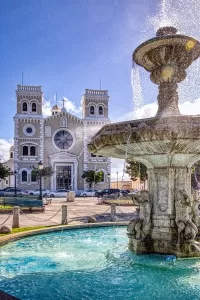
Saint Anthony of Padua Parish and Christopher Columbus Square Fountain
(click on image to see it larger)
Puerto Rico is a great place to write a travel blog. And if you’re covering the town of Guayama, it’s even better. Or is it?
Last year was a great year at Puerto Rico By GPS. After being sort of dormant for a very long time, we decided to “take the bull by the horns” and embark in a 3‑year project (more like three and a half). We decided to cover 26 of the 78 municipalities on the Island every year. At that rate it would take us exactly 3 years to cover all 78 towns (wishful thinking).
What actually happened was that we ended covering 23. But just think of it. Twenty three towns, with 23 videos and 23 elaborate blog posts in a single year “ain’t bad”. And if you throw in the two travel books that I also updated: “The Old San Juan Walking Tour” and “Puerto Rico Beach By Beach”, that “ain’t bad at all”.
After covering the town of Arroyo in November we decided to give it a rest ’til late January. Now why would I do a thing like that? Well, Puerto Rico has one of the longest Christmas seasons on the Planet. It extends from Thanksgiving Day to the San Sebastian Street Fiestas. Some people party even longer and celebrate something called “las octavitas”.
In any case, covering Christmas festivities falls into the realm of news; and I don’t do news in Puerto Rico By GPS. Why? Because news is totally the opposite of “evergreen”, which is what I strive for. What’s news today is history tomorrow, and nobody searches for “old news”. That’s called “history”.
Now that Christmas was over, we decided to visit the town of Guayama, on the southeastern coast of Puerto Rico.
Guayama is a beautiful town, with an even nicer Catholic Church and magnificent architecture. I couldn’t verify this piece of information, but there must be some sort of municipal ordinance protecting antique buildings in Guayama, because they are simply everywhere. Other towns on the Island have beautiful buildings from the Island’s Spanish colonial period, but many have demolished some of them and replaced them with boxy modern structures that break with the “old ambiance”.
I’ve always believed that you can tell a lot about a town’s history by just looking at its architecture. And in the case of Guayama you can tell that it was once an economic powerhouse. When exactly? Well, during the 18th and 19th centuries. Even during the first half of the 20th century if you would like to stretch things.
First it was an agricultural powerhouse under the Spanish colonial regime and then it became a sugar cane powerhouse under American rule. During the second half of the 20th century they betted it all on industrialization. That went well for a while, but it eventually collapsed when the U.S. Congressed repealed the tax code incentives that made it all possible.
Today there is still some industry in Guayama, but never as far reaching as what it was during the 1970’s, 80’s and 90’s. As for agriculture? It’s mostly gone as well.
My wife and I got to Guayama close to 9:00am. We always try to arrive early to catch the Catholic church open. It used to be that Catholic churches would remain open all day. But that was before vandalism and crime became a thing on the Island. Now it’s a different story. We have to remember that churches operate as NPOs (non profit organizations) so they don’t have the people —or the resources— to protect their houses of worship all day long. So, their only other option is to close while the temple is not in use.
When my wife and I arrived the temple was —in fact— closed. And it was a pity because the Catholic temple in Guayama is simply stunning. It’s called the Saint Anthony of Padua Parish (Parroquia San Antonio de Padua) and it was open in 1874.
The church is a twin tower Roman Catholic Parish built in the eclectic romanesque style, the only one of its kind in Puerto Rico. The bells were cast in Germany in 1835 of a bronze and gold alloy. They were donated by Catalina Algarín, a well-to-do local who requested that they be engraved with the names of her daughters Teodosia, Laureana and Estefanía.
The clock on the temple’s front facing wall was built in Switzerland by one of the most prestigious clockmakers of the day. The smaller clock, painted to its right, marks 11:30am, which was exactly the time when the temple was christened.
The lightning rod atop the tower was installed in 1881 and the church was inscribed in the National Register of Historic Places in 1976. Given the spectacular exterior of this magnificent temple, we couldn’t wait to see the interior. So we crossed the street, immediately behind the church, and went to the Parish office to see if there was someone available that could show us the church interior.
Of course, we told them who we were and why we were there, but still we were unable to see the church interior. At first glance it would seem like dropping in unannounced, and expecting to be accommodated, was kind of pretentious. But experience has taught us otherwise. When we started this series of visits, back in January of 2023, I tried contacting City Hall at each town and talking with someone in charge of tourism. The idea was to schedule our visits and have someone show us around and lay the groundwork. Sounds logical, right? Well, Puerto Rico doesn’t respond well to logic!!! The result was one or two answers out of dozens of emails and phone calls.
That’s why I do it like I do it. One, because I waste a lot less time and two, because that’s the way real tourists do it. They don’t call ahead. They just drop by. And if the experience is bad, they just write you up on social media. It’s the new world order.
After a disappointing first visit to the parish office, we decided to explore other attractions around town and return later to see if someone had “become available”.
Our next stop was at Christopher Columbus Square, better known among the locals as “Plaza de Recreo Cristóbal Colón”. In a word, it’s “beautiful”. The Guayama Christopher Columbus Square is known around Puerto Rico for its magnificent trees. But it’s way more than that. It’s a living, breathing, place of reunion and exchange. People actually enjoy each other’s company and talk to each other! Remarkable, right?
The plaza has a beautiful fountain in the center that was imported from France in 1918 by then mayor Genaro Cautiño Insúa. It also has gazebos, dozens of benches for people watching and lush well-pruned gardens. Come to think of it, I didn’t see a single piece of garbage on the floor or graffiti either. There seems to be a certain sense of pride here that’s somehow absent in other towns.
Towards the north end of the square there’s a bust honoring Luis Palés Matos, a local figure who was a writer, poet, newspaper reporter and one of Puerto Rico’s most important literary figures.
Across the street from the Luis Palés Matos bust is Guayama’s City Hall building. After striking out at the Saint Anthony of Padua Parish our idea was to visit City Hall and ask about other tourist attractions in town. Sadly, they were in the middle of a power outage. So the lady was more eager to get rid of us than to take care of us in the middle of that “sweaty” environment.
So far we had two strikes against us and things were looking kind’a bleak. So we decided to go to Casa Cautiño, on the northeast end of Christoper Columbus Square. And boy did we hit the motherload!
Casa Cautiño is a house-museum located on the corner of Vicente Palés and Santiago Palmer streets. The house was built for Genaro Cautiño Vázquez, a wealthy local landowner and businessman of Portuguese descent, who was also a colonel of the volunteer battalion for the Spanish Army.
Three generations of Cautiños called this place home throughout the years, including its original owner Genaro Cautiño Váquez and his wife Genoveva Insúa Billar, his son Genaro Cautiño Insúa and his wife Monserrate, and his grandson Genaro Cautiño Bruno and his wife.
In the back room there is a placard made of human hair that belonged to Juana Monserrate Vázquez. Doña Juana was actually Genaro Cautiño’s mother, who died of cholera at the young age of 32. Her husband, Manuel Cautiño (Genaro’s father) had her hair cut and the placard made to honor her memory.
Casa Cautiño is one of the rare museums in Puerto Rico in which every piece is an original. Not a single item has been brought from somewhere else or replaced with a replica. It has 16-foot ceilings and a host of details that make it special. So much so that it’s included in the National Archive of Historic Buildings.
The house is shaped like a U with a courtyard in the rear center. Admittance is free and the lady that took care of us was quite knowledgeable and friendly. She did, however, ask not to appear on camera, so we honored her wishes.
As we exited Casa Cautiño we decided to give the Church a second try. However, the young lady at the Parish office said that she still didn’t have anyone available to show us the temple interior.
We had several other places that we wanted to see on the outskirts of town, so we decided to go there and maybe return to the Parish Office for a third and final try sometime around noon.
Our first visit was to the old Machete Sugar Cane Mill. Like most sugar cane operations on the Island the Machete Mill is in a sad state of affairs. There’s nothing there except for a rusted building and the original smoke stack.
While exploring the map, in preparation for our visit to Guayama, I had seen a place called “Playita Machete” (Machete Beach). However, let me tell you right now: while Guayama is a coastal town, it’s certainly not a beach town by any stretch of imagination. Keep reading and you’ll see why.
Machete Beach is not a beach at all. It’s actually a stretch of houses that are built along the coast in a similar fashion as what we’ve seen in Patillas and at Las Picúas, in the town of Río Grande. They build the houses very close to the water and then string them together in such a way that it closes off access to the coast and obscures the beach altogether. You can hardly see the water.
My wife and I were asking ourselves “is this is even legal”, since the structures actually sit well within the terrestrial maritime zone. In any case, it keeps happening everywhere and the government doesn’t move a finger to stop it.
Next we tried a place called “Los Limones Beach”, which is actually at the end of a dead-end street. In this case, we’re talking about a wild beach behind a community, where there’s almost no place to park and no facilities at all. However, I was telling my wife that a landscape photographer could shoot some killer sunsets there because of the rugged terrain.
Finally, we visited Pozuelo Beach, which I guess you could call a beach, if you were into surfing and risking your life. The place has showers, gazebos, bathrooms and ample parking, but the surf was very menacing, to say the least. There was a man in charge who told us that the beach is extremely dangerous with high waves, riptides and water swirls. He also told us that surfers seem to love it!
In fact, as I approached the shore to shoot my video there was a surfer coming out of the water. If you ask me, I wouldn’t go anywhere close to that water. I did, however, manage to shoot some nice landscape shots.
Pozuelo Beach also proved to be a great place to have lunch, so my wife pulled out our cooler and we enjoyed some well deserved sandwiches and soft drinks.
Oh, and before I forget, I recently released the second edition of my book “Puerto Rico Beach By Beach”, where I explore 53 of the island’s most spectacular beaches. And believe me, there’s nothing else like it on the market.
My wife and I actually visited all 53 beaches, inspected them carefully, talked with the locals, shot pictures and video, and recorded the GPS coordinates. So the book includes detailed information, GPS coordinates, an online GPS map plotting all 53 beaches and access to an online video of each beach. That way you’ll be able to “visit before you visit” and go straight to the one you prefer when you get here.
For more information visit: puertoricobeachbybeach.com for the English version and puertoricoplayaporplaya.com for Spanish.
It was almost 1:00 o’clock when we returned to the parish office for the third time. This time there was a different lady, who obviously didn’t know anything about our first two attempts, and wasn’t able to find anyone to show us the temple interior either. So we decided to head back to San Juan.
At first glance you could say that we had it coming for not planning ahead, for not calling beforehand and scheduling a visit. But the fact is that no tourist in the world does that. They simply drop by unannounced.
So here are my two cents about Guayama. It’s a great town, with nice people and beautiful architecture. But it could be so much more. At least in the tourism sense.
I’ve said this before. So at the risk of sounding like a broken record, here I go again. There are actually tourists that go around the world visiting old churches. Don’t believe me? What do you think Rome is all about? Half of what you see in Rome are old churches. The same thing happens in Spain, England, France and all around Europe.
The not-so-obvious thing is that Puerto Rico has spectacular churches too. Why? Because Puerto Rico is over 500 years old and our culture is deeply rooted in Europe.
Now, I can understand why church officials don’t see their temples as tourists attractions. But the fact is that in many cases they are, whether they like it or not. And they can help infuse economic life to their respective towns. Why? Because people visit these temples and then they go on to visit the different museums and plazas, eat at the local restaurants and spend at the local stores.
What’s more, they shoot video with their smartphones, make pretty pictures and then put it all on social media, which in turn promotes the town and brings even more visitors.
But who am I to voice an opinion about these things. I’m just an old guy with his cameras that’s been traveling with his wife for over 40 years. So this isn’t something that I think. It’s actually something that I’ve seen. Repeatedly.
Guayama was just the first of a long string of towns that we hope to visit in 2024. And we’re going to keep doing what we do: dropping by unannounced —like real tourists do— producing videos and writing about our experiences. That’s the Puerto Rico By GPS promise and my audience wouldn’t have it any other way.
See you next time!
©2024,Orlando Mergal, MA
____________________
Bilingual Content Creator, Blogger, Podcaster,
Author, Photographer and New Media Expert
Tel. 787–750-0000, Mobile 787–306-1590
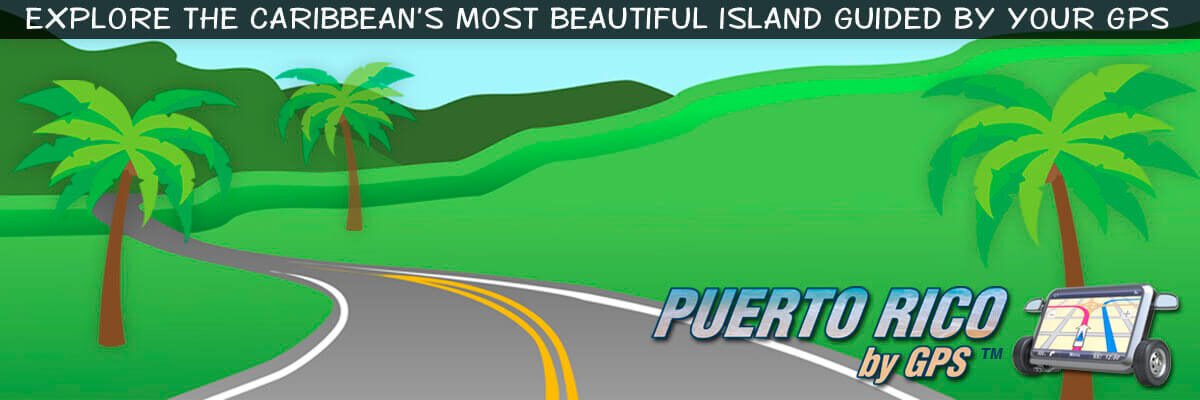
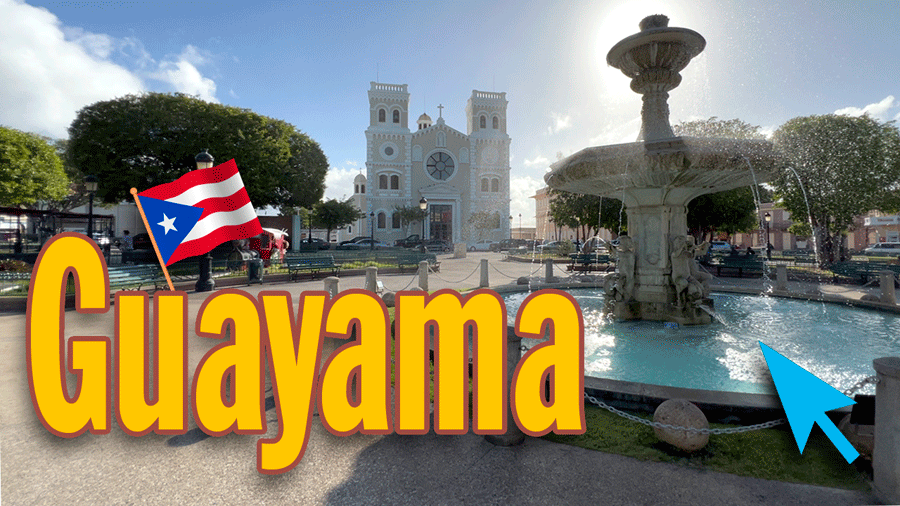
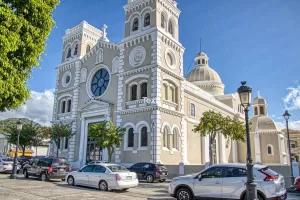
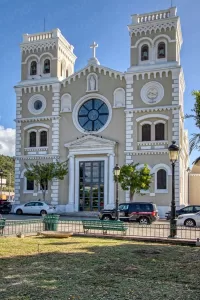
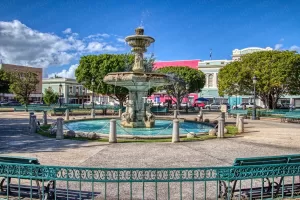
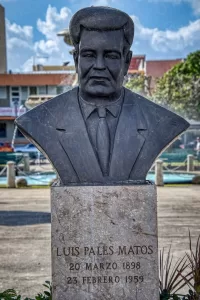
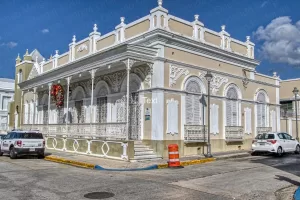
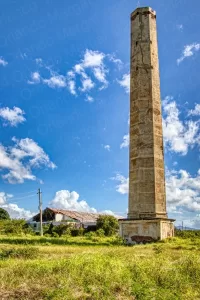
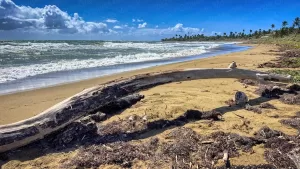

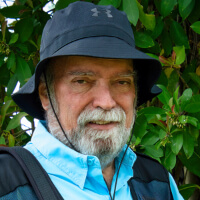
I enjoy reading your frank comments and agree wholeheartedly. Your photography is superb.I fell in love with the island as a young man 60+ years ago and made it my home. For years I helped promote the island as editor of Que Pasa, the government’s official tourism magazine. I could never have been as outspoken as you are about the negatives, however! At any rate, I only see the beauty!
Thank you for your kind words. I would love to mention only the positive aspects, but I am beholden by the very motto that I adopted on day 1, over 10 years ago: “we tell it like it is”. During my adult life I have travelled quite extensively. I’ve visited great places and others that were a waste of my time and money. And believe me, I would’ve loved to have someone like me to give it to me straight. I couldn’t live with myself if I were lying to my readers. Some people save all their lives to come to our shores. Shouldn’t we give them 110% of what they expect? I certainly think so.
Anyway, thanks again for your compliments. I was a reader of “Qué Pasa” back in the day and it was great. All the best. Orlando